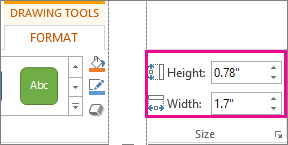

#STRETCH AN OBJECT WORD FOR MAC DOWNLOAD#
If you have a lot of pictures to size, download the free RnR PPTools Starter Set add-in ( ) and use the Place Exactly tool (the hammer icon) to quickly position images on your slides (see Figure 4-2).įigure 4-2. The Pick Up Size/Position tool and Place Exactly tool let you quickly position and place objects on your slides. Just make sure you properly size your images before you insert them into your presentation (see the sidebar, “Image Size in a Nutshell”). In all honesty, you probably don’t need to worry too much if your images appear slightly larger than desired. Another is you’ve scanned your image at a size way too large to fit onto the slide, or otherwise not optimized it for use in PowerPoint. As a result, PowerPoint doesn’t have anything to use to determine the actual size of the picture when you import it. One reason is some file types-GIFs, for example-don’t carry information about the file size or the dots per inch in the image. THE FIX: There are a whole bunch of different reasons for this. I started using Insert → Picture → From File to get images into my slides, but they’re too big when they come into PowerPoint. See the “Mother, May I?” sidebar in Chapter 8 for links to sites with copyright assistance. Just because it’s on the Internet doesn’t mean that copyrights don’t apply. Then use Insert → Picture → From File to insert the image into your presentation.Īnd make sure you have permission to use the images. If you must use graphics from a web site, right-click the graphic and choose Save Target As or Save Picture As to save it to your hard drive. You can try making a copy of your presentation and deleting images one at a time, saving after each deletion until you can isolate the problem image.

It won’t happen with every pasted image, and it won’t always happen even with the same presentation on different machines, so it may be difficult to pinpoint. If you paste a linked image onto your slide, you create an HTML object in your presentation, which sometimes causes PowerPoint to try to connect to the Internet. The actual image was located on a different web site. The problem is that the web site where you copied the image from really only contained a link to the image. THE FIX: Your presentation probably contains an image copied from the Internet and pasted directly onto a slide. Is Microsoft trying to phone home or something? THE ANNOYANCE: When I open my presentation, PowerPoint tries to connect to the Internet. My Presentation Tries to Connect to the Internet Save this presentation to your desktop also.
#STRETCH AN OBJECT WORD FOR MAC UPDATE#
It will update in your presentation file. Make a small change to the photo-maybe scribble on it with a pencil or brush tool-and then close it.

If your photo uses OLE embedding, the photograph will open in the default image-editing application you’ve assigned to. Close the image-editing application, and then double-click the photo in PowerPoint. Then move over to PowerPoint and paste it onto a slide. jpg file in Photoshop or another image-editing program. Now open a new, blank presentation file, as well as the. You should see the Format Object dialog box (see Figure 4-1). To see this for yourself, insert a JPG into a new, blank presentation file using Insert → Picture → From File. Although that can be handy, it comes at the price of increased file size. When you paste an image directly from Adobe Photoshop onto your PowerPoint slide, you’re pasting not only the image itself, but also a bunch of application overhead that lets you double-click the image on the slide to open up a Photoshop window and edit the photo from within PowerPoint. OLE stands for Object Linking and Embedding, which is kind of a dumb name because you can’t link and embed at the same time. It’s much better to save the image to your hard drive and then use Insert → Picture → From File to insert your images onto your slides. THE FIX: When you paste or drag and drop an image onto a PowerPoint slide, it sometimes creates what is known as an embedded OLE object.

THE ANNOYANCE: I dragged and dropped a picture into my PowerPoint file, and now my file is humongous.


 0 kommentar(er)
0 kommentar(er)
